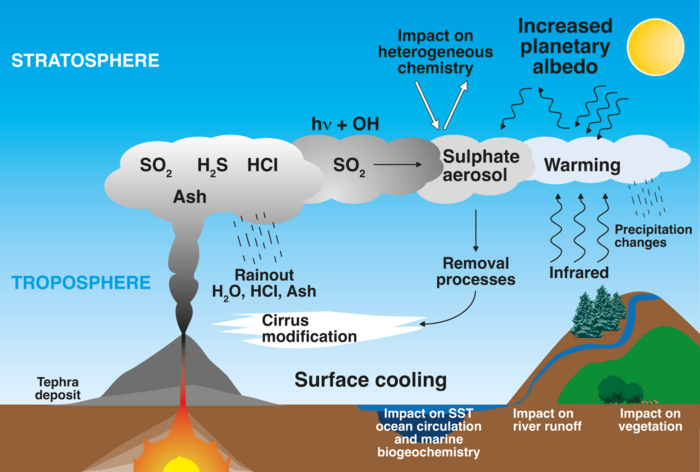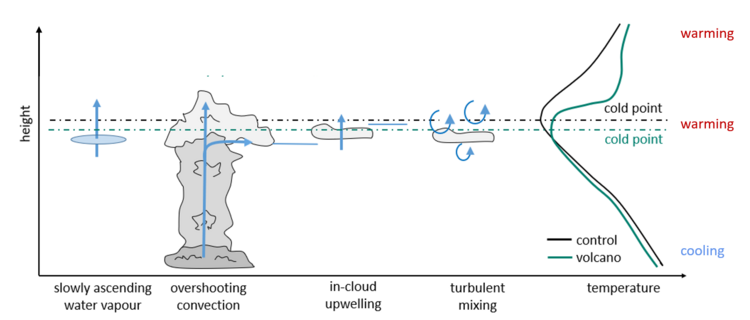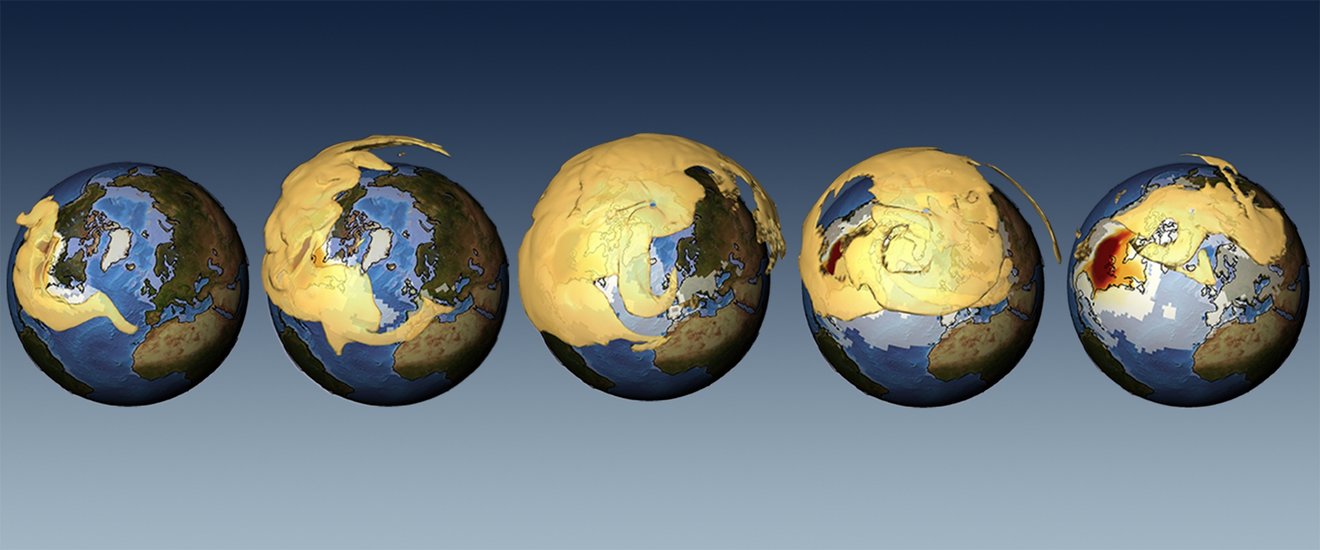
Stratospheric Forcing and Climate
The possibility of a large volcanic eruption provides arguably one of the largest uncertainty concerning the evolution of the climate system. Together with the varying solar activity and astronomical variations, strong volcanic eruptions are a major driving factor of natural climate variability. A sound knowledge of the impact of volcanic eruptions is therefore essential to understand both historical and possible future climate evolution. The overarching goal of the Stratospheric Forcing and Climate group is to advance the current scientific understanding of stratospheric forcing and its role in past, present, and future climate. We concentrate on stratospheric aerosols (volcanoes, stratospheric aerosol intervention modification (SAM)), but also consider other factors, such as solar and orbital forcing.
Our research questions are:
- How can stratospheric sulfur emissions be translated into forcing and which processes determine this?
- How is forcing related to climate response?
- How is natural variability masking volcanic signals in different time periods?
Our approach:
- To use global stratospheric aerosol models, high-resolution convection resolved models and Earth system models to separately investigate the pathways from the source to the stratospheric aerosol forcing and from the forcing to the climate effect.
- To exploit synergies between satellite and in-situ observations of stratospheric aerosol and global aerosol modeling of the spatial and temporal development of the volcanic cloud in the aftermath of recent eruptions.
- To explore new methods (e.g., data driven methodologies) to help identify signals that can be used to calibrate or constrain more simple conceptual, or impulse response, models and to interpret proxy records such as measurements from ice cores or the growth rate in tree rings
- To actively contribute to international activities like model intercomparison projects (ISA-MIP. VolMIP, GeoMIP).
Strong volcanic eruptions, which inject sulfur rich gases into the stratosphere, form stratospheric sulfate aerosol. The general understanding how stratospheric aerosol impact Earth’s climate is well-established; it changes the atmospheric radiation balance, leading to surface cooling and stratospheric warming. These two effects lead to changes in the atmospheric and ocean circulation and alter the hydrological and carbon cycle (Figure1). This results in a complicated picture of global and regional impacts on different time-scales. On the one hand, climate effects of volcanic eruptions depend on the eruption characteristic itself: emission strength and height, eruption latitude and season. On the other hand, they depend on initial background conditions, i.e. Greenhouse gas concentrations and internal modes of the climate system such as the phase of the El Niño-Southern Oscillation (ENSO) — which is a recurring climate pattern involving changes in the temperature of waters in the central and eastern tropical Pacific Ocean — or the quasi-biennial oscillation (QBO). The QBO is an oscillation of the equatorial zonal wind between easterlies and westerlies in the tropical stratosphere that occurs around every 2 years.
Research topics
Constraining radiative forcing
Volcanic radiative forcing depends on the aerosol size distribution. The simulated forcing of large volcanic eruptions differs strongly between various models. To better understand the reasons for these discrepancies among the global aerosol models, we have initiated the SSiRC international stratospheric aerosol model intercomparison project (ISA-MIP). ISA-MIP experiments have been designed to investigate key processes that influence the formation and temporal development of stratospheric aerosol in different times of the observational record.
For a given volcanic sulfur dioxide (SO2) emission, the model grid in combination with the prescribed emission scenarios will determine the stratospheric SO2 concentration and subsequently the initial evolution of the volcanic plume. We hypothesize that to better constrain aerosol radiative forcing requires a more realistic representation of the convective plume development on the global scale. We can test this hypothesis by performing simulations at high spatial resolutions, which finally makes it possible to link the mesoscale evolution and dynamics of volcanic clouds with the larger-scale circulation systems responsible for dispersing the plume.
![Volcanic ash cloud [mg/kg] a) three hours, b) one day and c) 4 days after an assumed eruption of the Laacher See volcano, simulated with ICON-ART. Anticyclonic motions at the top of the plume begin early and become stronger over time as the plume spreads. Anticyclonic motions at the top of the plume begin early and become stronger over time as the plume spreads. 4 days after the eruption, two ash clouds had formed, each spreading in a different direction but continuing to rotate. The rotation is the result of the absorption of solar and terrestrial radiation that heats the ash cloud. The warm cloud expands and begins to rotate.](/fileadmin/_processed_/8/a/csm_Fig2_Volcanic_ash_cloud_8e8f06a078.jpg)
Hydrological cycle
A key focus of our group in the upcoming years is placed on the volcanic impact on tropical hydroclimate, which is still a challenge for the recent generation of climate models. We are in particular interested in regional tropical precipitation responses and in the water vapor feedback. A heavily discussed topic over the last years is the volcanic impact on tropical climate variability, in particular El Niño Southern Oscillation (ENSO) and Asian Monsoon precipitation and the combined effect of both. Due to new developments in modeling capabilities and data driven methods (artificial intelligence/machine learning) on the one hand and due to the wealth of outcome from the Coupled Model Intercomparison Project (CMIP6) and large ensemble simulations on the other hand, we expect to improve current understanding on the volcanic impact on tropical hydroclimate.
Water vapor in the lower stratosphere has a particularly strong effect on the radiative balance of the Earth system. We therefore aim to understand how stratospheric aerosol forcing affects stratospheric water vapor and how this affects radiative forcing. We are interested not only in stratospheric water vapor changes due to changes in the large-scale circulation but also due to potential changes in deep convection (Figure 3), which refers to the thermally driven turbulent mixing that moves air parcels from the lower to the upper atmosphere. We address this issue with high-resolution models.
Past and future variability
A central research focus of our group is to identify detectable volcanic signals. This mostly becomes interesting as a way to use volcanic induced climate changes to constrain the behavior of the climate system. Here we will perform standard analyses taking advantage of the large amount of existing CMIP6/PMIP4 simulations and large ESM ensemble simulations. We are interested in past periods where volcanic forcing has a most prominent climate impact as in the mid 6th or in the early 19th century (Figure 4) or where the climate is in a transition phase as in Boelling Alleröd/Younger Dryas period. Also, in a future warmer climate natural impacts like a volcanic eruption will have an impact on the climate. We focus on the question if the same processes are relevant and have the same impact as in the present climate.
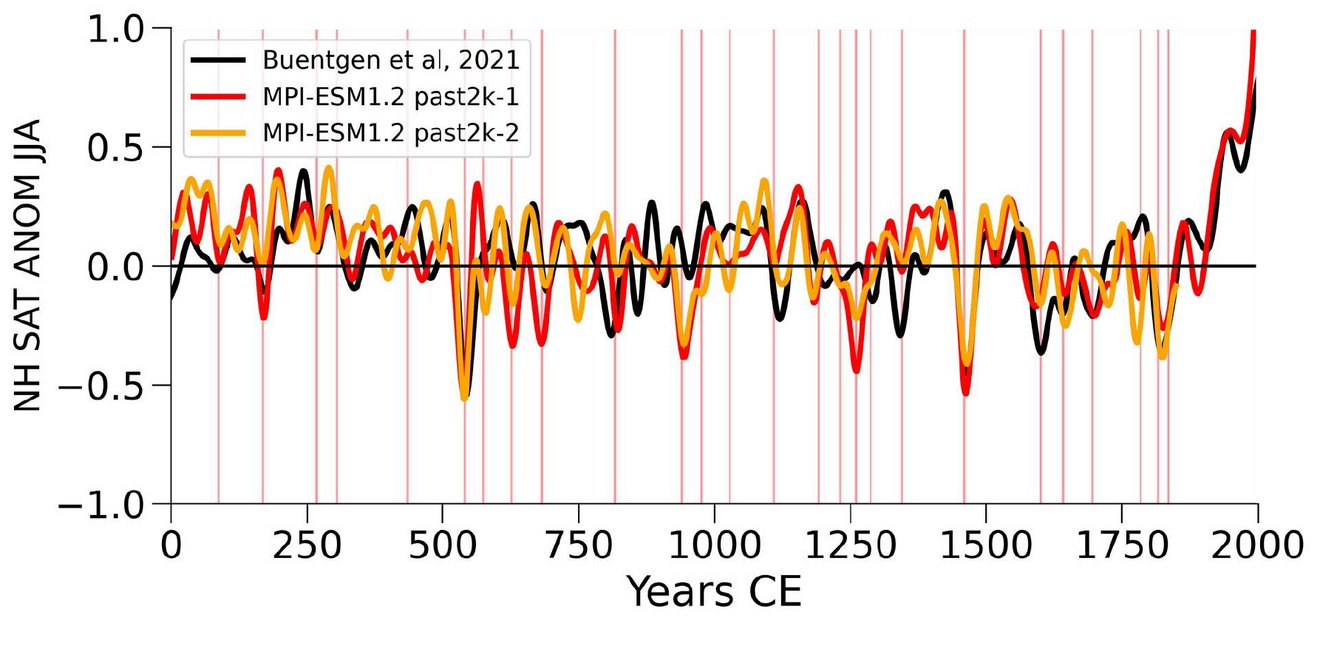
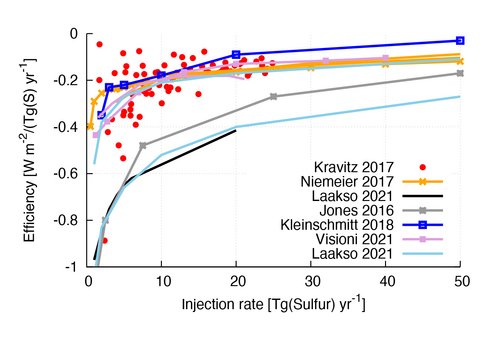
Stratospheric aerosol intervention (SAI)
Limiting the global temperature increase to at most 2 oC above pre-industrial levels, thus, achieving the Paris Agreementʼs aim, will require rapid and substantial greenhouse gas reductions. To reach this aim, large-scale use of 'negative emissions' — the removal and permanent storage of CO₂ from the atmosphere by the use of certain practices or technologies — might be necessary. It remains unclear whether they can be achieved. Therefore, the call for options to meet the 2 oC aim includes further 'Climate engineering' or 'geoengineering' methods, which are defined as the deliberate large-scale manipulation of climate.
One of these methods is called stratospheric aerosol intervention (SAI). A focus of our research is whether SAI can help to counteract climate change and what are potential consequences for atmosphere and climate. For SAI, SO2 is injected into the stratosphere at about 20 km altitude. SO2 gets oxidized and forms small sulfate particles. Sulfate scatters solar radiation. Consequently, less sunlight reaches the surface — a cooling effect. At the same time sulfate absorbs long wave radiation, which heats the artificial sulfate layer in the stratosphere. We aim for a better understanding of the effects of an artificial stratospheric sulfur layer by simulating the life cycle of sulfate with global aerosol models. We concentrate on the role of aerosol microphysical processes and transport on the final global aerosol distributions and on the impact of the aerosol induced heating on stratospheric dynamics. These are critical factors as so far the radiative forcing efficiency per injected amount mass differs between various models (Figure 5). The radiative forcing efficiency is a measure for the amount of cooling reached by SAI.
Further links
- DFG research group "Revisiting the volcanic impact on atmosphere and climate – preparations for the next big volcanic eruption" (VolImpact)
- BMBF/ROMIC project "Impact of SOlar, Volcanic and Internal variability on Climate" (ISOVIC)
- We participate in different model intercomparison projects:
- Simulating volcanically-forced climate variability: CMIP6/-VolMIP
- Sulfur emissions into the stratosphere to cool the climate: GEOMIP
- The role of volcanic eruptions in the last millenium: PMIP4- past2k
- Volcanic Impacts on Climate and Society: VICS-PAGE
- Sparc initiativs SSiRC (Stratospheric sulfur and its role in climate) and the model intercomparions ISA-MIP which compares model results performed with active aerosol microphysics.
Group members and publications
- Kroll, C., Schneidereit, A., Wills, R., Kornblueh, L. & Niemeier, U. (2025). Parameterization adaption needed to unlock the benefits of increased resolution for the ITCZ in ICON. EGUsphere, . doi:10.5194/egusphere-2025-1212 [Preprint] [pre-print]
- Lange, A., Niemeier, U., Rozanov, A. & von Savigny, C. (2025). Investigating the ability of satellite occultation instruments to monitor possible geoengineering experiments. EGUsphere, . doi:10.5194/egusphere-2025-1005 [Preprint] [pre-print]
- Andreasen, L., Cornér, J., Abbott, P., Sinclair, V., Riede, F. & Timmreck, C. (2024). Changes in Northern Hemisphere extra-tropical cyclone frequency following volcanic eruptions. Environmental research: climate, 3: 025002. doi:10.1088/2752-5295/ad2c0e [publisher-version]
- Brodowsky, C., Sukhodolov, T., Chiodo, G., Aquila, V., Bekki, S., Dhomse, S., Höpfner, M., Laakso, A., Mann, G., Niemeier, U., Pitari, G., Quaglia, I., Rozanov, E., Schmidt, A., Sekiya, T., Tilmes, S., Timmreck, C., Vattioni, S., Visioni, D., Yu, P., Zhu, Y. & Peter, T. (2024). Analysis of the global atmospheric background sulfur budget in a multi-model framework. Atmospheric Chemistry and Physics Discussions, 24, 5513-5548. doi:10.5194/acp-24-5513-2024 [publisher-version]
- Günther, M., Schmidt, H., Timmreck, C. & Toohey, M. (2024). Why does stratospheric aerosol forcing strongly cool the warm pool?. Atmospheric Chemistry and Physics Discussions, 24, 7203-7225. doi:10.5194/acp-24-7203-2024 [publisher-version]
- Kroll, C., Fueglistaler, S., Schmidt, H., Dauhut, T. & Timmreck, C. (2024). The impact of stratospheric aerosol heating on the frozen hydrometeor transport pathways in the tropical tropopause layer. Environmental Research Letters, 19: 044039. doi:10.1088/1748-9326/ad33d0 [supplementary-material][publisher-version]
- Kroll, C. & Schmidt, A. (2024). Indirect stratospheric moisture increase after a Pinatubo-magnitude eruption can be comparable to direct increase after 2022 Hunga. Communications Earth & Environment, 5: 497. doi:10.1038/s43247-024-01651-w [publisher-version][any-fulltext]
- Laakso, A., Visioni, D., Niemeier, U., Tilmes, S. & Kokkola, H. (2024). Dependency of the impacts of geoengineering on the stratospheric sulfur injection strategy – Part 2: How changes in the hydrological cycle depend on the injection rate and model used. Earth System Dynamics Discussions, 15, 405-427. doi:10.5194/esd-15-405-2024 [publisher-version]
- Lionello, P., D'Agostino, R., Ferreira, D., Nguyen, H. & Singh, M. (2024). The Hadley circulation in a changing climate. Annals of the New York Academy of Sciences, 1534, 69-93. doi:10.1111/nyas.15114 [publisher-version]
- Meuer, J., Timmreck, C., Fang, S.-W. & Kadow, C. (2024). Fingerprints of past volcanic eruptions can be detected in historical climate records using machine learning. Communications Earth & Environment, 5: 455. doi:10.1038/s43247-024-01617-y [publisher-version][supplementary-material]
- Schmidt, H., Rast, S., Bao, J., Fang, S.-W., Jiménez de la Cuesta Otero, D., Keil, P., Kluft, L., Kroll, C., Lang, T., Niemeier, U., Schneidereit , A., Williams , A. & Stevens, B. (2024). Effects of vertical grid spacing on the climate simulated in the ICON-Sapphire global storm-resolving model. Geoscientific Model Development, 17, 1563-1584. doi:10.5194/egusphere-2023-1575 [supplementary-material][publisher-version]
- Sospedra-Alfonso, R., Merryfield, W., Toohey, M., Timmreck, C., Vernier, J.-P., Bethke, I., Wang, Y., Bilbao, R., Donat, M., Ortega, P., Cole, J., Lee, W.-S., Delworth, T., Paynter, D., Zeng, F., Zhang, L., Khodri, M., Mignot, J., Swingedouw, D., Torres, O., Hu, S., Man, W., Zuo, M., Hermanson, L., Smith, D., Kataoka, T. & Tatebe, H. (2024). Decadal prediction centers prepare for a major volcanic eruption. Bulletin of the American Meteorological Society, 105(12), E2496 – E2524. doi:10.1175/BAMS-D-23-0111.1 [publisher-version]
- Timmreck, C., Olonscheck, D., Ballinger, A., D’Agostino, R., Fang, S.-W., Schurer, A. & Hegerl, G. (2024). Linearity of the climate response to increasingly strong tropical volcanic eruptions in a large ensemble framework. Journal of Climate, 37, 2455-2470. doi:10.1175/JCLI-D-23-0408.1 [supplementary-material]
- Timmreck, C., D'Agostino, R., Fang, S.-W., Ballinger, A., Hegerl, G., Kang, S. & Olonscheck, D. (2024). Relative role of land and ocean in shaping tropical hydroclimate after large volcanic eruptions. . EGU General Assembly 2024. Wien. 2024-04-14 - 2024-04-19 doi:10.5194/egusphere-egu24-6543 [abstract]
- van Dijk, E., Jungclaus, J., Sigl, M., Timmreck, C. & Krüger, K. (2024). High-frequency climate forcing causes prolonged cold periods in the Holocene. Communications Earth & Environment, 5: 242. doi:10.1038/s43247-024-01380-0 [publisher-version]
- Vernier, J.-P., Aubry, T., Timmreck, C., Schmidt, A., Clarisse, L., Prata, F., Theys, N., Prata, A., Mann, G., Choi, H., Carn, S., Rigby, R., Loughlin, S. & Stevenson, J. (2024). The 2019 Raikoke eruption as a testbed used by the Volcano Response group for rapid assessment of volcanic atmospheric impacts. Atmospheric Chemistry and Physics, 24, 5765-5782. doi:10.5194/egusphere-2023-1116 [publisher-version]
- Visioni, D., Robock, A., Haywood, J., Henry, M., Tilmes, S., MacMartin, D., Kravitz, B., Doherty, S., Moore, J., Lennard, C., Watanabe, S., Muri, H., Niemeier, U., Boucher, O., Syed, A., Egbebiyi, T., Seferian, R. & Quaglia, I. (2024). G6-1.5K-SAI: a new Geoengineering Model Intercomparison Project (GeoMIP) experiment integrating recent advances in solar radiation modification studies. Geoscientific Model Development, 17, 2583-2596. doi:10.5194/gmd-17-2583-2024 [publisher-version]
- Bruckert, J., Hoshyaripour, G., Hirsch, L., Horvath, A., Kahn, R., Kölling, T., Muser, L., Timmreck, C., Vogel, H., Wallis, S. & Vogel, B. (2023). Dispersion and aging of volcanic aerosols after the La Soufriere eruption in April 2021. Journal of Geophysical Research: Atmospheres, 128: e2022JD037694. doi:10.1029/2022JD037694 [publisher-version]
- Chen, Y., Ji, D., Zhang, Q., Moore, J., Boucher, O., Jones, A., Lurton, T., Mills, M., Niemeier, U., Séférian, R. & Tilmes, S. (2023). Northern-high-latitude permafrost and terrestrial carbon response to two solar geoengineering scenarios. Earth System Dynamics, 14, 55-79. doi:10.5194/esd-14-55-2023 [publisher-version]
- Fang, S.-W., Sigl, M., Toohey, M., Jungclaus, J., Zanchettin, D. & Timmreck, C. (2023). The role of small to moderate volcanic eruptions in the early 19th century climate. Geophysical Research Letters, 50: e2023GL105307. doi:10.1029/2023GL105307 [publisher-version]
- Freychet, N., Schurer, A., Ballinger, A., Suarez-Gutierrez, L. & Timmreck, C. (2023). Assessing the impact of very large volcanic eruptions on the risk of extreme climate events. Environmental Research: Climate, 2: 035015 . doi:10.1088/2752-5295/acee9f [publisher-version]
- Hohenegger, C., Korn, P., Linardakis, L., Redler, R., Schnur, R., Adamidis, P., Bao, J., Bastin, S., Behravesh, M., Bergemann, M., Biercamp, J., Bockelmann, H., Brokopf, R., Brüggemann, N., Casaroli, L., Chegini, F., Datseris, G., Esch, M., George, G., Giorgetta, M., Gutjahr, O., Haak, H., Hanke, M., Ilyina, T., Jahns, T., Jungclaus, J., Kern, M., Klocke, D., Kluft, L., Kölling, T., Kornblueh, L., Kosukhin, S., Kroll, C., Lee, J., Mauritsen, T., Mehlmann, C., Mieslinger, T., Naumann, A., Paccini, L., Peinado, A., Praturi, D., Putrasahan, D., Rast, S., Riddick, T., Roeber, N., Schmidt, H., Schulzweida, U., Schütte, F., Segura, H., Shevchenko, R., Singh, V., Specht, M., Stephan, C., von Storch, J., Vogel, R., Wengel, C., Winkler, M., Ziemen, F., Marotzke, J. & Stevens, B. (2023). ICON-Sapphire: simulating the components of the Earth System and their interactions at kilometer and subkilometer scales. Geoscientific Model Development, 16, 779-811. doi:10.5194/gmd-16-779-2023 [publisher-version]
- Kroll, C. (2023). The volcanic impact on moisture fluxes into the stratosphere. Phd Thesis, Hamburg: Universität Hamburg. Berichte zur Erdsystemforschung, 262. doi:10.17617/2.3489355 [publisher-version]
- Kroll, C., Fueglistaler, S., Schmidt, H., Kornblueh, L. & Timmreck, C. (2023). The sensitivity of moisture flux partitioning in the cold-point tropopause to external forcing. Geophysical Research Letters, 50: e2022GL102262. doi:10.1029/2022GL102262 [supplementary-material][publisher-version]
- Niemeier, U. (2023). Eine künstliche stratosphärische Schwefelschicht: Der einfache Ausweg aus dem Klimaproblem?. In Lozán, J., Grassl, H., Breckle, S.-W., Kasang, D. & Quante, M. (Eds.), Warnsignal Klima: Hilft Technik gegen die Erderwärmung? (pp.243-249). Hamburg: Wissenschaftliche Auswertungen. [publisher-version]
- Niemeier, U., Wallis, S., Timmreck, C., van Pham, T. & von Savigny, C. (2023). How the Hunga Tonga - Hunga Ha'apai water vapor cloud impacts its transport through the stratosphere: dynamical and radiative effects. Geophysical Research Letters, 50: e2023GL106482. doi:10.1029/2023GL106482 [publisher-version]
- Quaglia, I., Timmreck, C., Niemeier, U., Visioni, D., Pitari, G., Brodowsky, C., Brühl, C., Dhomse, S., Franke, H., Laakso, A., Mann, G., Rozanov, E. & Sukhodolov, T. (2023). Interactive stratospheric aerosol models' response to different amounts and altitudes of SO2 injection during the 1991 Pinatubo eruption. Atmospheric Chemistry and Physics, 23, 921-948. doi:10.5194/acp-23-921-2023 [publisher-version][supplementary-material]
- Timmreck, C. (2023). Abkühlung durch starke vulkanische Eruptionen und ihre Nebeneffekte. In Lozán, J., Grassl, H., Breckle, S.-W., Kasang, D. & Quante, M. (Eds.), Warnsignal Klima: Hilft Technik gegen die Erderwärmung? (pp.237-242). Hamburg: Wissenschaftliche Auswertungen. [publisher-version]
- van Dijk, E., Gundersen, I., de Bode, A., Høeg, H., Loftsgarden, K., Iversen, F., Timmreck, C., Jungclaus, J. & Krüger, K. (2023). Climatic and societal impacts in Scandinavia following the 536 and 540 CE volcanic double event. Climate of the Past, 19, 357-398. doi:10.5194/cp-19-357-2023 [publisher-version]
- Villamayor, J., Khodri, M., Fang, S.-W., Jungclaus, J., Timmreck, C. & Zanchettin, D. (2023). Sahel droughts induced by large volcanic eruptions over the last millennium in PMIP4/Past1000 simulations. Geophysical Research Letters, 50: e2022GL101478. doi:10.1029/2022GL101478 [publisher-version]
- Visioni, D., Kravitz, B., Robock, A., Tilmes, S., Haywood, J., Boucher, O., Lawrence, M., Irvine, P., Niemeier, U., Xia, L., Chiodo, G., Lennard, C., Watanabe, S., Moore, J. & Muri, H. (2023). Opinion: The scientific and community-building roles of the Geoengineering Model Intercomparison Project (GeoMIP)-past, present, and future. Atmospheric Chemistry and Physics, 23, 5149-5176. doi:10.5194/acp-23-5149-2023 [publisher-version]
- Wrana, F., Niemeier, U., Thomason, L., Wallis, S. & von Savigny, C. (2023). Stratospheric aerosol size reduction after volcanic eruptions. Atmospheric Chemistry and Physics, 23, 9725-9743. doi:10.5194/acp-23-9725-2023 [publisher-version]
- Zanchettin, D., Fang, S.-W., Khodri, M., Omrani, N.-E., Rubinetti, S., Rubino, A., Timmreck, C. & Jungclaus, J. (2023). Thermohaline patterns of intrinsic Atlantic multidecadal variability in MPI-ESM-LR. Climate Dynamics, available online.. doi:10.1007/s00382-023-06679-w
- D'Agostino, R. & Timmreck, C. (2022). Sensitivity of regional monsoons to idealised equatorial volcanic eruption of different sulfur emission strengths. Environmental Research Letters, 17: 054001. doi:10.1088/1748-9326/ac62af [publisher-version]
- Fang, S.-W., Timmreck, C., Jungclaus, J., Krüger , K. & Schmidt, H. (2022). On the additivity of climate responses to the volcanic and solar forcing in the early 19th century.. Earth System Dynamics, 13, 1535-1555. doi:10.5194/esd-13-1535-2022 [pre-print][supplementary-material][publisher-version]
- Günther, M., Schmidt, H., Timmreck, C. & Toohey, M. (2022). Climate feedback to stratospheric aerosol forcing: the key role of the pattern effect. Journal of Climate, 35, 4303-4317. doi:10.1175/JCLI-D-22-0306.1 [publisher-version]
- Haywood, J., Tilmes, S., Jones, A., Keutsch, F., Laakso, A., Niemeier, U., Schmidt, A., Visioni, D. & Yu, P. (2022). Stratospheric aerosol injection and its potential effect on the stratospheric ozone layer. In World Meteorological Organisation (WMO) (Eds.), Scientific Assessment of ozone depletion: 2022 (pp.325-383). Genf: World Meteorological Organization.
- Jones, A., Haywood, J., Scaife, A., Boucher, O., Henry, M., Kravitz, B., Lurton, T., Nabat, P., Niemeier, U., Seferian, R., Tilmes, S. & Visioni, D. (2022). The impact of stratospheric aerosol intervention on the North Atlantic and Quasi-Biennial Oscillations in the Geoengineering Model Intercomparison Project (GeoMIP) G6sulfur experiment. Atmospheric Chemistry and Physics, 22, 2999-3016. doi:10.5194/acp-22-2999-2022 [publisher-version]
- Laakso, A., Niemeier, U., Visioni, D., Tilmes, S. & Kokkola, H. (2022). Dependency of the impacts of geoengineering on the stratospheric sulfur injection strategy - Part 1: Intercomparison of modal and sectional aerosol modules. Atmospheric Chemistry and Physics, 22, 93-118. doi:10.5194/acp-22-93-2022 [publisher-version][supplementary-material]
- Marshall, L., Maters, E., Schmidt, A., Timmreck, C., Robock, A. & Toohey, M. (2022). Volcanic effects on climate: recent advances and future avenues. Bulletin of Volcanology, 84: 54. doi:10.1007/s00445-022-01559-3 [publisher-version]
- Tilmes, S., Visioni, D., Jones, A., Haywood, J., Seferian, R., Nabat, P., Boucher, O., Bednarz, E. & Niemeier, U. (2022). Stratospheric ozone response to sulfate aerosol and solar dimming climate interventions based on the G6 Geoengineering Model Intercomparison Project (GeoMIP) simulations. Atmospheric Chemistry and Physics, 22, 4557-4579. doi:10.5194/acp-22-4557-2022 [publisher-version]
- van Dijk, E., Jungclaus, J., Lorenz, S., Timmreck, C. & Krueger, K. (2022). Was there a volcanic-induced long-lasting cooling over the Northern Hemisphere in the mid-6th-7th century?. Climate of the Past, 18, 1601-1623. doi:10.5194/cp-18-1601-2022 [publisher-version]
- Weisenstein, D., Visioni, D., Franke, H., Niemeier, U., Vattioni, S., Chiodo, G., Peter, T. & Keith, D. (2022). An interactive stratospheric aerosol model intercomparison of solar geoengineering by stratospheric injection of SO2 or accumulation-mode sulfuric acid aerosols. Atmospheric Chemistry and Physics, 22, 2955-2973. doi:10.5194/acp-22-2955-2022 [publisher-version]
- Zanchettin, D., Timmreck, C., Khodri, M., Schmidt, A., Toohey, M., Abe, M., Bekki, S., Cole, J., Fang, S.-W., Feng, W., Hegerl, G., Johnson, B., Lebas, N., Legrande, A., Mann, G., Marshall, L., Rieger, L., Robock, A., Rubinetti, S., Tsigaridis, K. & Weierbach, H. (2022). Effects of forcing differences and initial conditions on inter-model agreement in the VolMIP volc-pinatubo-full experiment. Geoscientific Model Development, 15, 2265-2292. doi:10.5194/gmd-15-2265-2022 [publisher-version]
- Abbott, P., Niemeier, U., Timmreck, C., Riede, F., McConnell, J., Severi, M., Fischer, H., Svensson, A., Toohey, M., Reinig, F. & Sigl, M. (2021). Volcanic climate forcing preceding the inception of the Younger Dryas: Implications for tracing the Laacher See eruption. Quaternary Science Reviews, 274: 107260. doi:10.1016/j.quascirev.2021.107260 [publisher-version]
- Azoulay, A., Schmidt, H. & Timmreck, C. (2021). The Arctic polar vortex response to volcanic forcing of different strengths. Journal of Geophysical Research: Atmospheres, 126: e2020JD034450. doi:10.1029/2020JD034450 [supplementary-material][publisher-version]
- Brenna, H., Kutterolf, S., Mills, M., Niemeier, U., Timmreck, C. & Krüger, K. (2021). Decadal disruption of the QBO by tropical volcanic supereruptions. Geophysical Research Letters, 48: e2020GL089687. doi:10.1029/2020GL089687 [publisher-version]
- Clyne, M., Lamarque, J.-F., Mills, M., Khodri, M., Ball, W., Bekki, S., Dhomse, S., Lebas, N., Mann, G., Marshall, L., Niemeier, U., Poulain, V., Robock, A., Rozanov, E., Schmidt, A., Stenke, A., Sukhodolov, T., Timmreck, C., Toohey, M., Tummon, F., Zanchettin, D., Zhu, Y. & Toon, O. (2021). Model physics and chemistry causing intermodel disagreement within the VolMIP-Tambora Interactive Stratospheric Aerosol ensemble. Atmospheric Chemistry and Physics, 31, 3317-3343. doi:10.5194/acp-21-3317-2021 [publisher-version][supplementary-material]
- Fang, S.-W., Khodri, M., Timmreck, C., Zanchettin, D. & Jungclaus, J. (2021). Disentangling internal and external contributions to Atlantic multidecadal variabilityover the past millennium. Geophysical Research Letters, 48: e2021GL095990. doi:10.1029/2021GL095990 [publisher-version]
- Franke, H., Niemeier, U. & Visioni, D. (2021). Differences in the QBO response to stratospheric aerosol modification depending on injection strategy and species. Atmospheric Chemistry and Physics, 21, 8615-8635. doi:10.5194/acp-21-8615-2021 [supplementary-material][publisher-version][supplementary-material]
- Jones, C., Hickman, J., Rumbold, S., Walton, J., Lamboll, R., Skeie, R., Fiedler, S., Forster, P., Rogelj, J., Abe, M., Botzet, M., Calvin, K., Cassou, C., Cole, J., Davini, P., Deushi, M., Dix, M., Fyfe, J., Gillett, N., Ilyina, T., Kawamiya, M., Kelley, M., Kharin, S., Koshiro, T., Li, H., Mackallah, C., Müller, W., Nabat, P., van Noije, T., Nolan, P., Ohgaito, R., Olivié, D., Oshima, N., Parodi, J., Reerink, T., Ren, L., Romanou, A., Séférian, R., Tang, Y., Timmreck, C., Tjiputra, J., Tourigny, E., Tsigaridis, K., Wang, H., Wu, M., Wyser, K., Yang, S., Yang, Y. & Ziehn, T. (2021). The climate response to emissions reductions due to COVID-19: Initial results from CovidMIP. Geophysical Research Letters, 48: e2020GL091883. doi:10.1029/2020GL091883 [publisher-version]
- Kravitz, B., MacMartin, D., Visioni, D., Boucher, O., Cole, J., Haywood, J., Jones, A., Lurton, T., Nabat, P., Niemeier, U., Robock, A., Séférian, R. & Tilmes, S. (2021). Comparing different generations of idealized solar geoengineering simulations in the Geoengineering Model Intercomparison Project (GeoMIP). Atmospheric Chemistry and Physics, 21, 4231-4247. doi:10.5194/acp-21-4231-2021 [publisher-version]
- Kroll , C., Dacie, S., Azoulay, A., Schmidt, H. & Timmreck, C. (2021). The impact of volcanic eruptions of different magnitude on stratospheric water vapour in the tropics. Atmospheric Chemistry and Physics, 21, 6565-6591. doi:10.5194/acp-21-6565-2021 [supplementary-material][publisher-version]
- Malinina, E., Rozanov, A., Niemeier, U., Peglow, S., Arosio, C., Wrana, F., Timmreck, C., von Savigny, C. & Burrows, J. (2021). Changes in stratospheric aerosol extinction coefficient after the 2018 Ambae eruption as seen by OMPS-LP and ECHAM5-HAM. Atmospheric Chemistry and Physics, 21, 14871-14891. doi:10.5194/acp-21-14871-2021 [publisher-version][supplementary-material]
- Niemeier, U., Riede, F. & Timmreck, C. (2021). Simulation of ash clouds after a Laacher See-type eruption. Climate of the Past, 17, 633-652. doi:10.5194/cp-17-633-2021 [publisher-version][supplementary-material]
- Timmreck, C., Toohey, M., Zanchettin, D., Brönnimann, S., Lundstadt, E. & Wilson, R. (2021). The unidentified eruption of 1809: a climatic cold case. Climate of the Past, 17, 1455-1482. doi:10.5194/cp-17-1455-2021 [supplementary-material][publisher-version][supplementary-material]
- Visioni, D., Macmartin, D., Kravitz, B., Boucher, O., Jones, A., Lurton, T., Martine, M., Mills, M., Nabat, P., Niemeier, U., Séférian, R. & Tilmes, S. (2021). Identifying the sources of uncertainty in climate model simulations of solar radiation modification with the G6sulfur and G6solar Geoengineering Model Intercomparison Project (GeoMIP) simulations. Atmospheric Chemistry and Physics, 21, 10039-10063. doi:10.5194/acp-21-10039-2021 [publisher-version][supplementary-material]
- Fiedler, S., Crueger, T., D'Agostino, R., Peters, K., Becker, T., Leutwyler, D., Paccini, L., Burdanowitz, J., Buehler, S., Uribe, A., Dauhut, T., Dommenget, D., Fraedrich, K., Jungandreas, L., Maher, N., Naumann, A., Rugenstein, M., Sakradzija, M., Schmidt, H., Sielmann, F., Stephan, C., Timmreck, C., Zhu , X. & Stevens, B. (2020). Simulated tropical precipitation assessed across three major phases of the Coupled Model Intercomparison Project (CMIP). Monthly Weather Review, 148, 3653-3680. doi:10.1175/MWR-D-19-0404.1 [publisher-version][supplementary-material]
- Hermanson, L., Bilbao, R., Dunstone, N., Ménégoz, M., Ortega, P., Pohlmann, H., Robson, J., Smith, D., Strand, G., Timmreck, C., Yeager, S. & Danabasoglu, G. (2020). Robust multiyear climate impacts of volcanic eruptions in decadal prediction systems. Journal of Geophysical Research: Atmospheres, 125: e2019JD031739. doi:10.1029/2019JD031739 [publisher-version]
- Niemeier, U., Richter, J. & Tilmes, S. (2020). Differing responses of the quasi-biennial oscillation to artificial SO2 injections in two global models. Atmospheric Chemistry and Physics, 20, 8975-8987. doi:10.5194/acp-20-8975-2020 [publisher-version]
- Riede, F., Hussain, S., Timmreck, C. & Svenning, J.-C. (2020). CLIOdynamic ARCHaeology: computational approaches to final Palaeolithic/Early Mesolithic archaeology and climate change. Antiquity, 94: e13. doi:10.15184/aqy.2020.85 [publisher-version]
- Schröder, T. (2020). Riskante Kühlung. MaxPlanckForschung, 3/20, 70-77. [publisher-version]
- von Savigny, C., Timmreck, C., Buehler, S., Burrows, J., Giorgetta, M., Hegerl, G., Horvath, A., Hoshyaripour, G., Hoose, C., Quaas, J., Malinina, E., Rozanov, A., Schmidt, H., Thomason, L., Toohey, M. & Vogel, B. (2020). The Research Unit VolImpact: Revisiting the volcanic impact on atmosphere and climate – preparations for the next big volcanic eruption. Meteorologische Zeitschrift, 3-18. doi:10.1127/metz/2019/0999 [publisher-version]
- Niemeier, U., Timmreck, C. & Krüger , K. (2019). Revisiting the Agung 1963 volcanic forcing: Impact of one or two eruptions. Atmospheric Chemistry and Physics, 19, 10379-10390. doi:10.5194/acp-19-10379-2019 [publisher-version][supplementary-material]
- Pfrommer, T., Goeschl, T., Proelss, A., Carrier, M., Lenhard, J., Martin, H., Niemeier, U. & Schmidt, H. (2019). Establishing causation in climate litigation: admissibility and reliability. Climatic Change, 152, 67-84. doi:10.1007/s10584-018-2362-4
- Schurer, A., Hegerl, G., Luterbacher, J., Brönnimann, S., Cowan, T., Tett, S., Zanchettin, D. & Timmreck, C. (2019). Disentangling the causes of the 1816 European year without a summer. Environmental Research Letters, 14: 094019. doi:10.1088/1748-9326/ab3a10 [publisher-version][supplementary-material]
- Toohey, M., Krüger, K., Schmidt, H., Timmreck, C., Sigl, M., Stoffel, M. & Wilson, R. (2019). Disproportionately strong climate forcing from extratropical explosive volcanic eruptions. Nature Geoscience, 12, 100-107. doi:10.1038/s41561-018-0286-2
- Zanchettin, D., Timmreck, C., Toohey, M., Jungclaus, J., Bittner, M., Lorenz, S. & Rubino, A. (2019). Clarifying the relative role of forcing uncertainties and initial-condition unknowns in spreading the climate response to volcanic eruptions. Geophysical Research Letters, 46, 1602-1611. doi:10.1029/2018GL081018 [publisher-version]
- Illing, S., Kadow, C., Pohlmann, H. & Timmreck, C. (2018). Assessing the impact of a future volcanic eruption on decadal predictions. Earth System Dynamics, 9, 701-715. doi:10.5194/esd-9-701-2018 [publisher-version][supplementary-material]
- Kravitz, B., Rasch, P., Wang, H., Robock, A., Gabriel, C., Boucher, O., Cole, J., Haywood, J., Ji, D., Jones, A., Lenton, A., Moore, J., Muri, H., Niemeier, U., Phipps, S., Schmidt, H., Watanabe, S., Yang, S. & Yoon, J.-H. (2018). The climate effects of increasing ocean albedo: An idealized representation of solar geoengineering. Atmospheric Chemistry and Physics, 18, 13097-13113. doi:10.5194/acp-18-13097-2018 [publisher-version][supplementary-material]
- Lühr, B. & Timmreck, C. (2018). Vulkane und Klima. In Lozán, J., Breckle, S.-W., Grassl, H., Kasang, D. & Weisse, R. (Eds.), Warnsignal Klima: Extremereignisse - wissenschaftliche Fakten (pp.250-254). Hamburg: Wissenschaftliche Auswertungen. [publisher-version]
- Marshall, L., Schmidt, A., Toohey, M., Carslaw, K., Mann, G., Sigl, M., Khodri, M., Timmreck, C., Zanchettin, D., Ball, W., Bekki, S., Brooke, J., Dhomse, S., Johnson, C., Lamarque, J.-F., LeGrande, A., Mills, M., Niemeier, U., Poulain, V., Robock, A., Rozanov, E., Stenke, A., Sukhodolov, T., Tilmes, S., Tsigaridis, K. & Tummon, F. (2018). Multi-model comparison of the volcanic sulfate deposition from the 1815 eruption of Mt. Tambora. Atmospheric Chemistry and Physics, 18, 2307-2328. doi:10.5194/acp-2017-729 [publisher-version][supplementary-material]
- Muri, H., Tjiputra, J., Otterå, O., Adakudlu, M., Lauvset, S., Grini, A., Schulz, M., Niemeier, U. & Kristjánsson, J. (2018). Climate response to aerosol geoengineering: a multimethod comparison. Journal of Climate, 31, 6319-6340. doi:10.1175/JCLI-D-17-0620.1 [publisher-version][publisher-version]
- Niemeier, U. (2018). Climate-Engineering: ein Wundermittel gegen den Klimawandel ?. In Lozán, J., Breckle, S.-W., Grassl, H., Kasang, D. & Weisse, R. (Eds.), Warnsignal Klima: Extremereignisse - wissenschaftliche Fakten (pp.357-361). Hamburg: Wissenschaftliche Auswertungen. [publisher-version]
- Sonntag, S., Ferrer-Gonzalez, M., Ilyina, T., Kracher, D., Nabel, J., Niemeier, U., Pongratz, J., Reick, C. & Schmidt, H. (2018). Quantifying and comparing effects of climate engineering methods in the earth system. Earth's Future, 6, 149-168. doi:10.1002/2017EF000620 [publisher-version]
- Stjern, C., Muri, H., Ahlm, L., Boucher, O., Cole, J., Ji, D., Jones, A., Haywood, J., Kravitz, B., Lenton, A., Moore, J., Niemeier, U., Phipps, S., Schmidt, H., Watanabe, S. & Kristjánsson, J. (2018). Response to marine cloud brightening in a multi-model ensemble. Atmospheric Chemistry and Physics, 18, 621-634. doi:10.5194/acp-18-621-2018 [publisher-version][supplementary-material]
- Timmreck, C., Mann, G., Aquila, V., Hommel , R., Lee, L., Schmidt, A., Brühl, C., Carn, S., Chin, M., Dhomse, S., Diehl, T., English, J., Mills, M., Neely, R., Sheng, J., Toohey , M. & Weisenstein, D. (2018). The Interactive Stratospheric Aerosol Model Intercomparison Project (ISA-MIP): Motivation and experimental design. Geoscientific Model Development, 11, 2581-2608. doi:10.5194/gmd-2017-308 [publisher-version][supplementary-material]
- Timmreck, C. (2018). Climatic effects of large volcanic eruptions. Habilitation Thesis, Hamburg: Universität Hamburg. Berichte zur Erdsystemforschung, 204. doi:10.17617/2.2566000 [publisher-version]
- Timmreck, C. (1997). Simulationen zur Bildung und Entwicklung von stratosphärischem Aerosol unter besonderer Berücksichtigung der Pinatuboepisode. Phd Thesis, Hamburg: University of Hamburg. Examensarbeit / Max-Planck-Institut für Meteorologie, 46. [publisher-version]
Contact
Dr. Claudia Timmreck
Group leader
Phone: +49 (0)40 41173-384
claudia.timmreck@mpimet.mpg.de
More Content

Why stratospheric aerosol disproportionately cools the Indian and western Pacific Ocean
In a new study Moritz Günther, Hauke Schmidt, Claudia Timmreck, and Matthew Toohey show how aerosol perturbations in the stratosphere lead to a…
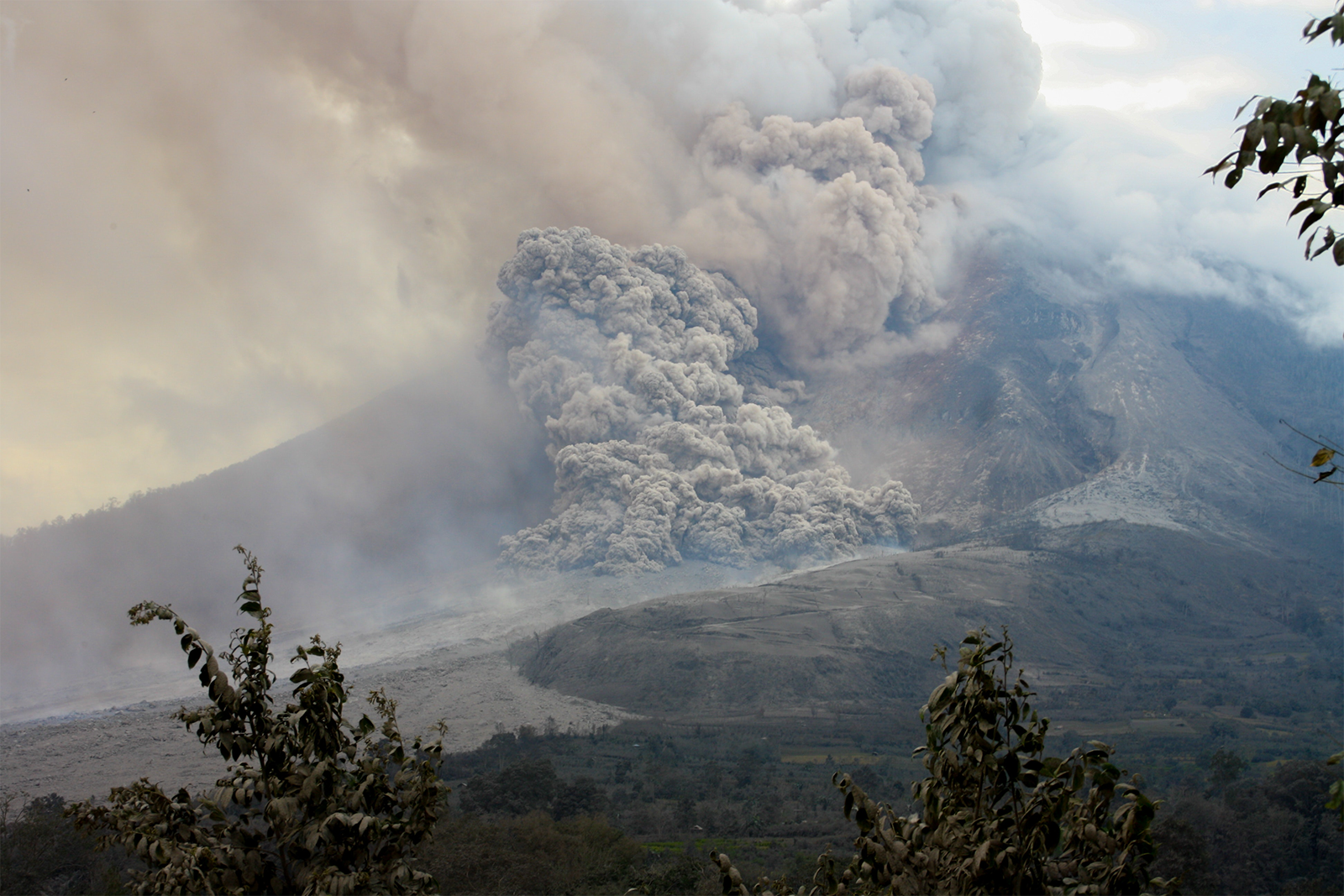
Climate feedback to stratospheric aerosol forcing: the key role of the pattern effect
In a recent study Moritz Günther, Hauke Schmidt, Claudia Timmreck (all MPI-M), and Matthew Toohey (University of Saskatchewan) argue why the cooling…

